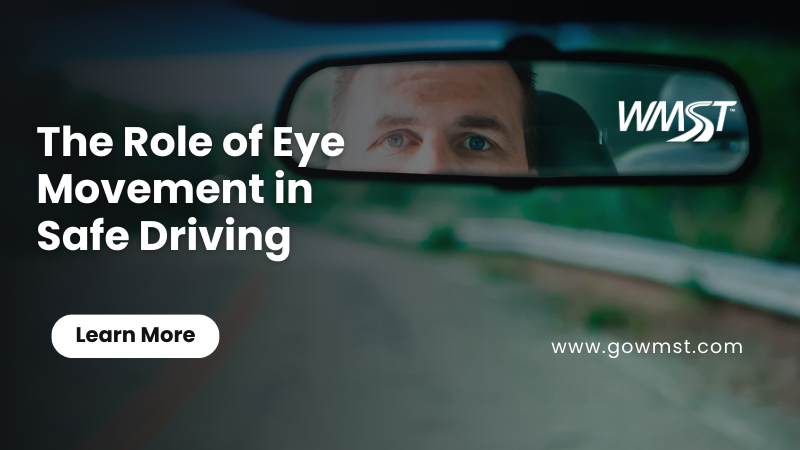Why Eye Scanning Is Key to Accident Prevention?
When most people think of driving, they focus on steering, braking, or accelerating. Yet one of the most critical aspects of safe driving isn’t about your hands or feet, it’s about your eyes.
In Washington, the Department of Licensing requires drivers to demonstrate proper scanning techniques during the Skills Test. Why? Because accidents rarely happen without warning. In fact, most crashes can be avoided if drivers spot hazards early enough to react.
Eye scanning helps new drivers:
- Detect potential dangers like pedestrians, cyclists, or sudden lane changes.
- Monitor traffic lights and signs without losing track of the road ahead.
- Stay aware of vehicles approaching from behind or alongside.
- Anticipate the movement of other drivers before it becomes a problem.
- Identify likely spots where unseen cars may emerge.
En WMST, instructors emphasize that safe driving begins with the eyes. Learning where and when to look sets the foundation for everything else behind the wheel.
How to Maintain a 360-Degree Awareness?
One of the most important habits every driver must develop is maintaining a constant 360-degree awareness. This doesn’t mean staring everywhere at once—it means scanning strategically so that nothing surprises you.
Key habits include:
- Look far up the road Don’t just look at the car in front—look up 12–15 seconds ahead to anticipate traffic, stops, turns, or hazards.
- Scan back left to right to your vehicle, looking for hidden hazards, any movement, pedestrians and bicycles and areas blocked from view.
- Check mirrors. This helps you keep track of vehicles behind and beside you.
- Look up the road and scan back.
- Check your speed.
- Repeat
- Don’t fixate. Staring at one spot can cause you to miss something important elsewhere.
By practicing these techniques, drivers reduce the chance of sudden surprises and improve reaction time dramatically. Visit How to Maximize Your Learning During Driving School?
The WMST Scanning Technique for New Drivers
WMST uses a proven method to help new drivers master scanning. The approach combines mirror checks, head turns, and forward vision into a repeatable pattern:
- Start with looking up the road as far as you can see — not just directly in front of your hood.
- Scan your way back to your vehicle – anticipate hidden dangers.
- Mirror and speed check — alternate checking your mirrors and speedometer.
- Look over your shoulder — when changing lanes or merging, always confirm blind spots.
- Return to forward vision — re-center your eyes on the road ahead.
- Repeat continuously — keep cycling through this process every few seconds.
This method may feel repetitive at first, but with practice, it becomes second nature. Examiners on the Skills Test will specifically look for these movements to confirm that you’re scanning correctly.
How to Spot Hazards Early?
Hazard detection is where scanning truly pays off. The sooner you see something, the more options you have to respond safely.
Common hazards to watch for in WA:
- Pedestrians stepping into crosswalks unexpectedly.
- Cyclists sharing narrow lanes.
- Parked cars with doors opening into traffic.
- Sudden stops from vehicles ahead.
- Las condiciones climáticas like rain, fog, or glare that reduce visibility.
WMST instructors train students to “read the road” like a story. By scanning consistently, drivers can predict what might happen next rather than reacting at the last second.
For example: If you see brake lights several cars ahead, you can begin slowing down early. If you notice a ball rolling into the street, you can anticipate a child may follow. These small predictions make a huge difference in safety.
Practicing Eye Movement on Every Drive
Eye scanning is a skill that improves only through repetition. WMST recommends incorporating scanning practice into every single drive.
Here are some effective ways to build strong eye movement habits:
- Practice in low-traffic areas first. Focus on mirror checks and head turns without heavy distractions.
- Add scanning “checkpoints.” For example, every time you pass a street sign, check your mirrors.
- Narrate your observations. Saying out loud what you see (“car behind me, pedestrian at crosswalk”) reinforces the habit.
- Gradually increase complexity. Move from quiet neighborhoods to busier streets and eventually highways.
- Ask for feedback. WMST instructors can spot when a student is missing critical scans and provide corrections immediately.
By turning scanning into muscle memory, students not only pass the Skills Test but also develop habits that keep them safe for a lifetime.
FAQs
Is eye scanning graded during the driving test?
Yes. Examiners watch to see if you’re checking mirrors, looking over your shoulder, and scanning ahead consistently.
How often should I check mirrors?
Continuously alternate checking your mirrors and speedometer after looking up the road and scanning your way back to your vehicle.
Can I fail for not looking over my shoulder?
Yes. Failing to check blind spots when required—such as before a lane change—can result in point deductions or automatic failure.
How far ahead should I look?
Aim to look 12–15 seconds up the road to anticipate upcoming traffic or hazards.
Does WMST teach defensive vision skills?
Absolutely. WMST instructors integrate hazard detection and scanning techniques into both classroom and behind-the-wheel training.
Conclusion
Safe driving in Washington isn’t just about steering and braking, it’s about seeing the whole picture. Eye scanning plays a central role in preventing accidents, spotting hazards early, and passing the Skills Test.
WMST’s scanning method gives new drivers a reliable structure for maintaining awareness in every situation. By practicing mirror checks, head turns, and forward vision, students quickly build the habits that keep them confident and safe on the road.
Whether you’re preparing for your first test or looking to sharpen your skills, remember: your eyes are your best safety tool.

